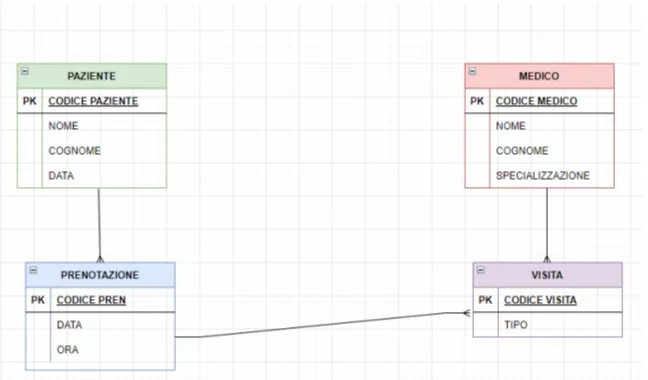
Ho deciso di iniziare questo progetto, consiste nel prendere tracce di esercizi/analisi di casi reali, e studiarli, quindi fare il modello concettuale, logico (visti nei post precedenti, ed anche l'sql...iniziamo!!
Progettare un modello di dati per la gestione automatizzata delle prestazioni specialistiche del servizio sanitario per consentire le prenotazioni agli sportelli con controllo della disponibilità e registrazione della prenotazione.
i dati da organizzare sono:
-I medici che operano presso i servizi sanitario;
-I diversi tipi di visite specialistiche;
-Le informazioni anagrafiche dei pazienti che richiedono le visite;
-Le prenotazioni delle visite da parte dei pazienti
Per prima cosa rileggiamo la traccia in modo tale da capire cosa ci chiede e individuare l'entità e vari attributi.
possiamo subito notare che l'entità principali che spiccano sono quattro ovvero paziente, medico, no prenotazione e visita.
Dopo aver fatto ciò individuiamo i vari attributi quindi se la traccia non ci dice quali sono i vari attributi andremo noi ad intuizione a descriverli...ad esempio paziente avrà obbligatoriamente una chiave primaria, potremmo mettere o il codice fiscale o una chiave chiamata codice paziente e tra gli attributi mettiamo nome cognome e data di nascita.
-Tra gli attributi di medico invece mettiamo una chiave primaria un nome un cognome ed una specializzazione, per prenotazione oltre alla chiave primaria ci basterà mettere anche solo la data, poiché la traccia non ci chiede altro...stessa cosa per visita.

Dopo aver individuato le varie entità e vari attributi procediamo con lo schema concettuale;
poiché un paziente può avere delle prenotazioni, delle prenotazioni possono avere delle visite e un medico può avere più visite colleghiamo:
-paziente a prenotazione
-prenotazione a visita
-visita a medico
Per quanto riguarda invece il tipo di relazione abbiamo paziente a prenotazione e lo mettiamo come un 1/n poiché un paziente può avere più prenotazioni ed una prenotazione può avere un solo paziente...dopodiché prenotazione a visita perché una prenotazione può avere più visite e per ultimo medico a visita un n ad n poiché un medico avere più visite e una visita può avere più medici

come ultimo passaggio ci tocca eseguire lo schema logico...per fare lo schema logico digitiamo il nome delle entità che a noi serve tra le parentesi come primo attributo inseriamo la chiave primaria dopodiché distaccati dalla, tutti i nostri attributi e per ultimo Un'eventuale chiave esterna, ricordate sempre che la chiave primaria andrà sottolineata... L'ordine da seguire sarà sempre partire dall’entità senza chiave sterna fino all’entità con una o più chiavi esterne.


I decided to start this project, it consists of taking traces of exercises/analysis of real cases, and study them, then do the conceptual model, logic (seen in previous posts, and also the sql...let's start!!!
Design a data model for the automated management of health service specialist services to allow reservations at the counters with availability control and reservation registration.
The data to be organized are:
-Doctors working at health services;
-The different types of specialist visits;
-The master information of patients requesting visits;
-The reservations of the visits by the patients
We first reread the trace so that we understand what it is asking for and identify the entity and various attributes.
we can immediately see that the main entities that stand out are four namely patient, physician, no reservation and visit.
After doing that we identify the various attributes so if the trace doesn't tell us what the various attributes are we will go by intuition to describe them...for example patient will mandatorily have a primary key, we could put either the social security number or a key called patient code and among the attributes we put first name last name and date of birth.
-Between the attributes of doctor instead we put a primary key a first name a last name and a specialty, for reservation in addition to the primary key we will also only need to put the date, since the trace does not ask us anything else...same thing for visit.

Having identified the various entities and various attributes we proceed with the conceptual schema;
since a patient can have reservations, reservations can have visits, and a physician can have multiple visits we link:
-patient to reservation
-reservation to visit
-visit to physician
On the other hand, regarding the type of relationship we have patient to reservation and we put it as a 1/n since a patient can have multiple reservations and a reservation can have only one patient...after that reservation to visit because a reservation can have multiple visits and last doctor to visit a n to n since a doctor have multiple visits and a visit can have multiple doctors

as the last step we have to perform the logical schema...to make the logical schema we type the name of the entities that we need in the parentheses as the first attribute we insert the primary key after that detached from the, all our attributes and last A possible foreign key, always remember that the primary key will be underlined... The order to follow will always be starting from the entity with no foreign key to the entity with one or more foreign keys.
